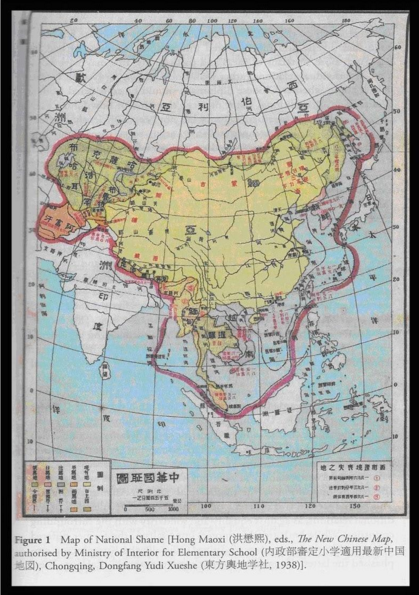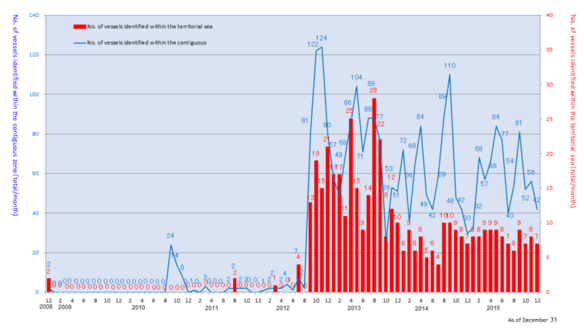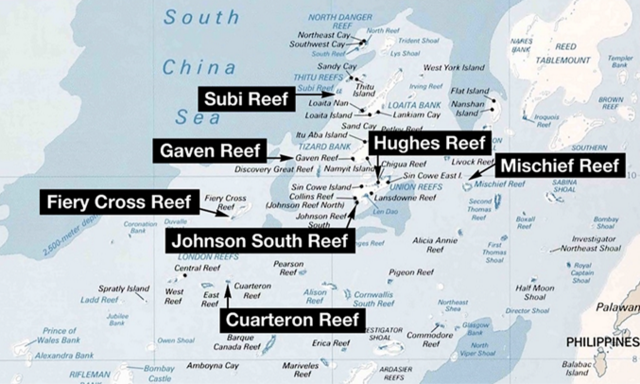Australia is considering conducting its own freedom-of-navigation exercise in the South China Sea. That is good because things are coming to a head and everyone in East Asia should state, unequivocally, where they stand. Even the UK has chosen, wisely, and announced increased defense cooperation with Japan. The head of U.S. Pacific Command, Admiral Harry Harris, has said that freedom-of-navigation exercises will grow in frequency, complexity and scope.
For maximum effect this should include a visit the Sierra Madre on Second Thomas Shoal in the Spratlys Islands. This is a World War 2 tank-landing ship that the Philippine Navy ran up on the reef in 1999. It is manned by a dozen Filipino marines. As a Filipino naval asset, an attack by China on the Sierra Madre would trigger the U.S.-Philippines Defense Treaty. China keeps two of its coast guard vessels circling the reef in an attempt to stop resupply of the base. The Philippines has resorted to air-dropping supplies to its outpost. This has been going on for a few years now and apparently China is somewhat miffed that the Philippines hasn’t given up yet. A visit to the Sierra Madre would be much appreciated by the marines there, who crave vegetables.
This war has been coming for a long time. Consider the following map which is from a Nationalist grade school textbook from 1938:

There’s more than a little Lebensraum in that map, which looks somewhat like a map of the Greater East Asia Co-Prosperity Sphere. In fact if Japan hadn’t got into race-based aggression against its neighbours first, China would have been on the warpath years ago. These days the Japanese are very polite about not flaunting their racial superiority. China has yet to learn that lesson, which can only be learnt from harsh experience. Unfortunately it seems that it is the lot of this generation to provide that harsh experience. Things might settle down afterwards.
China has been building bases in the Spratly Islands since the 1990s and things could have drifted along for decades more. Unfortunately President Xi is one of those leaders who seeks to have greatness thrust upon him. The baiting of the Japanese only really started once he became China’s leader as shown by this graphic from the Ministry of Foreign Affairs of Japan website showing Chinese intrusions into Japanese territorial waters:

Those intrusions only took off in an organized way once Xi was in charge. The baiting is his doing, but to what end? It is an attempt to psychologically wear down Japan prior to an attack. Japan is well aware of that and that is why they have signed a defence agreement with the Philippines. The problem for Xi is that there is no down-ramp from his chosen path of war. The South China Sea is now marked as Chinese territory on Chinese passports. If he was to back down now, he might lose control of the Party, and the Party might lose control of China. The dictatorship in China is of the sort that gets rid of party rivals by executing them, so Xi has bet the farm on his coming war.
China has completed one airfield in the Spratlys, with two to go. Combined with the other four island bases, they give each other mutual fire support. While we can make a stab at what China’s war plan is, the question that remains is the likely timing. What pays for all this belligerence is China’s economy. Once the economy stops growing, then it is no longer a consideration and regime legitimacy must come from something dramatic and unifying. As at December 2015, China’s economic growth rate had fallen to 4 percent with strong prospects of actual contraction starting at some stage in 2016. The size of the contraction in prospect is indicated by comments by the deputy chairman of the China Iron & Steel Association that a fall in steel production from 800 to 500 million tonnes per annum would be “still healthy.”
Thus the rush to build the bases in the Spratlys. From Xi’s perspective, the planets could be aligned for war as early as the second quarter of 2016. China would announce that its forbearance of foreigners occupying its sacred lands and seas in the South China Sea has reached its limit and it would then attack the bases of all the other countries in the Spratlys.
Some have seen this war coming for years. Robert Kaplan wrote an article in The Atlantic in June 2005 entitled “How We Would Fight China.” As he says in the introduction to that article, “The Middle East is just a blip. The American military contest with China in the Pacific will define the twenty-first century. And China will be a more formidable adversary than Russia ever was.” That is reflected in American military analysis which seems to be devoted 99 percent to China with almost no discussion of Russia or the Middle East.
Ideally for China, they would attack in the Spratlys and the United States would not respond. For completeness, this Youtube video shows what China’s last attack in the Spratlys, in 1988, was like. It shows unarmed Vietnamese soldiers standing on Johnson South Reef and being machine gunned by the Chinese (for the purists it is more likely 20 mm cannon fire).
The United States, under Obama, would be inclined to say that possession of some rocks doesn’t trigger their defence treaties in the region, but they won’t have a choice. Japan realises that if China is successful in seizing the South China Sea, they will be next on the agenda, possibly some time in 2017. So Japan will come to the aid of the Philippines irrespective of what the United States might do. That is why Japan signed a basing agreement with the Philippines and changed its constitution. It will be easier for Japan to defeat China with the help of Vietnam and the Philippines than take on China by itself, later.
How can Japan be sure that it is going to be attacked? Well, China keeps telling Japan that they will. For example, consider this detail from Beijing’s military parade on 3rd September last year: “The military parade thus started with the People’s Liberation Army (PLA) National Flag Guard marching 121 heavy steps to the flag pole at the center of Tiananmen Square, reminding Japan the number of years the Chinese have been in waiting since 1894 for “appropriate” reparations and for an expression of regret.” And further from Admiral Harris,“the Chinese Coast Guard continues to build a mammoth “cutter” displacing 12,500 tons — a quarter more than a U.S. Arleigh Burke destroyer — with a bow reinforced for ramming. Since the Chinese Coast Guard has played aggressive bad cop to the PLA Navy’s good cop in disputed waters, the construction of such a ship suggests Philippine, Vietnamese, or Japanese coast guard vessels are going to take some hard hits in the near future.”
China’s question will be the same as Japan’s upon its entry into World War 2. Leave the United States alone in the hope that it doesn’t enter the war or mount a surprise attack at the outset to destroy as much as possible? Chinese military strategy favours surprise attack and so the answer will be the same – attack the United States at the outset. China, Japan and the United States would each have come to the conclusion that this is what is going to happen. The only thing that could stop that from happening is if the United States set out to stop Japan from coming to the aid of the Philippines. But that in turn would mean that most of the countries in Asia would acquire nuclear weapons to protect themselves from China.
China’s preparation for war can be followed by satellite imagery and the PAVE PAWS early warning radar on top of Mt. Leshan in central Taiwan. This radar can see 5,000 km into China in great detail. So the United States will get some warning of the rain of ballistic and cruise missiles on its bases from Japan to Guam. Most US aircraft in the Asian region sit out in the open on bases. If they stay put, most will be destroyed in by a rain of missiles with cluster munitions. So it seems that, as the threat rises, U.S. aircraft will be dispersed away from their current bases to airfields just outside the Chinese threat arc. If sent to Australia, they won’t have that far to travel back to the war theatre. Psychologically it is important that they don’t leave the war theatre. That is why the United States is looking to Australia to provide some strategic depth.
U.S. operational doctrine is to wait for the initial Chinese attack, absorb it and then go on the offensive straight away. This explains a remark by the head of U.S. Pacific Command on his appointment in May 2015,“If called upon, we would fight tonight,” on message with the deputy commander of U.S. Army Pacific’s words the previous day of “being ready to ‘fight tonight.’” The U.S. response will await the hours of darkness on day one because it will rely upon a lot of decoy and jammer cruise missiles to shield the aircraft carrying bombs.
The Allied cause was given a big boost by a decision of the Philippines Supreme Court on 12th January, 2016 to allow the United States the use of military bases in the country, dismissing an appeal by leftists. The facilities include the Antonio Bautista Air Base, with an 8,500 foot runway on Palawan, Fort Magsaysay Airfield (5,000 ft), Clark Air Base (10,000 ft), Basa Airbase (8,000 ft), and the Subic Bay Airfield (8,700 ft), on Luzon, and Benito Ebuen Air Base on Cebu (10,500 ft).
This allows U.S., Japanese and Australian aircraft to operate much closer to the South China Sea. Andersen Air Force Base on Guam might become a smoking ruin, but Allied aircraft will be able to surge back to the Philippines and have a much higher sortie rate in the Spratlys.
The bases China has built in the Spratlys have made it easier to defeat China than if they didn’t exist. To put that into context, there are two strategic concepts for defeating Chinese aggression. The first is Air-Sea Battle, in the vein of Air-Land Battle of the European theatre, now renamed Joint Concept for Access and Maneuver in the Global Commons. This is the traditional concept of destroying the enemy by destroying his centre of gravity, in this case killing people and breaking things on the Chinese mainland. That is an undertaking not to be taken lightly. The second strategic concept is Offshore Control. In this second concept, nobody sets foot on the Chinese mainland. Maritime cordons are set at the first and second island chains and all Chinese shipping, commercial and military, is either sunk or taken as a war prize. Manilla Bay could be a perfect anchorage for holding a lot of these ships. There are a lot of similarly ideal anchorages throughout the Philippines.
The problem with the first concept is that it is going to be expensive in terms of aircraft shot down and servicemen killed. And the outcome will be open to doubt. The problem with the second concept is that involves waiting for the Chinese to tap the mat. That might take a while as it might need for President Xi and his faction to be killed in a coup. This is where the seven new Chinese bases on seven new islands become useful. The South China Sea is a natural kill box, much the same as the Mediterranean proved to be during World War 2. Chinese aircraft and ships supporting their bases in the Spratlys would have to run the 600 mile-long gauntlet from Hainan Island. If the Chinese aircraft and ships try to stay away from the Vietnamese on the western side, they make it easier for American aircraft to attack them from the east, coming and going. They will have a low survival rate. Now we get to the important bit. Attack on and occupation of the Chinese bases in the Spratlys will provide a defeat of Chinese land forces early in the war and this will be important psychologically in the Chinese accepting defeat. Those bases, shown on the following map, have just made China more vulnerable.

It will be a small-scale rerun of the island hopping of the Pacific campaign of World War 2. This campaign will start with the air base on Mischief Reef, 250 km west of Palawan. This puts it in range of ATACMS missiles with a range of 300 km. The United States has possibly some 2,000 of these in stock. The amphibious attack on Mischief Reef will be associated with the suppression of the airfields on Subi Reef and Fiery Cross Reef. From Mischief Reef, it is then on to the airfield on Subi Reef and then all the other island bases can be rolled up. The Chinese Navy and air force will exhaust themselves in trying to protect these bases, which is a very good thing. Those Spratly bases are China’s point, and moment, of weakness.
Some Chinese academics have crowed that China has already won the coming war because President Obama doesn’t have the stomach for a major war, as demonstrated by his announcing red lines and then not enforcing them. But just as his penchant for drone attacks on jihadists is a surprising character quirk in an otherwise avowed dove, he did spend some formative years in Indonesia where anti-Chinese sentiment is strong.
As to why we have to fight China, good advice comes from people who have been fighting the Chinese for over one thousand years. As quoted in the Pentagon Papers, Ho Chi Minh said,“the white man is finished in Asia. But if the Chinese stay now, they will never leave. As for me, I prefer to smell French shit for five years, rather than Chinese shit for the rest of my life.” Take that advice to heart – a smaller war now is better than a bigger one later.
David Archibald is the author of Twilight of Abundance (Regnery)


